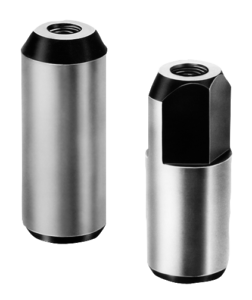Rolling bearings from norelem
Rolling bearings are a type of mechanical bearing used to support and protect moving parts in machines and applications. The rolling bearing uses a rolling motion to facilitate all movements and reduce friction. The smooth movement of the parts reduces wear and extends the machine's service life. They can withstand high speeds and are suitable for the precise, low-friction bearing support of rotary movements.
Operating principle of rolling bearings
If the bearing is installed correctly, it connects a stationary frame or housing to a rotating shaft. The rolling bearing now absorbs the forces of the parts and at the same time holds the parts in their specific position. The rolling elements located between the inside and outside ring transmit the forces of the bearing. Depending on the design, the rolling bearing can transmit forces in axial, radial or combined (axial and radial) directions. Lubricant on the rings reduces the friction between the individual components of the rolling bearing.
Versions from norelem
The range includes single-row, double-row and single direction bearings, in addition to rolling bearings with a cylindrical hole. Rolling bearings can also be equipped with a cage, which holds the rolling elements in position. norelem offers rolling bearings made of stainless steel, steel, ceramic and ball-bearing steel.
Rolling bearings in different sizes
norelem has rolling bearings in a wide range of sizes. A distinction is made between the inside and outside diameter. The selection of rolling bearings includes those with an inside diameter of 3 mm to 50 mm or rolling bearings with an outside diameter of 10 mm to 110 mm.
Special sizes are also available with tolerance, e.g. inside diameter 10-0.008 mm. The first number (10) is the nominal value of the inside diameter in millimetres. The second number (-0.008) is the tolerance of the inside diameter and is also given in millimetres.
Subgroups of rolling bearings
Rolling bearings are available in different versions. norelem has a wide range of products and differentiates between rolling bearings as follows.
Version | Properties |
Ball bearings | - Properties: robust and lightweight - Si3N4 is the preferred material for ceramic bearings - Affordable alternative to Si3N4 - Thermal expansion is similar to that of steel, which is seen as an advantage of zirconium oxide (ZrO2) |
- Withstands high speeds - Absorption of axial loads in one direction (against the shoulder guide) - An additional bearing is required to provide axial counter guidance; it must be arranged as a mirror image - Pressure angle of 40° makes the bearing axially loadable | |
- Designed for high permissible load - Compensation of angular misalignments by the spherical roller bearings - Absorption of high radial and axial loads (axial loads possible in both directions) - Main dimensions comply with DIN 635-2, dimensional and running tolerances of tolerance class PN comply with DIN 620 - Radial bearing clearance is equal to bearing clearance CN acc. to DIN 620-4 | |
- Supplied without seal - Ideally suited for high speeds - Can absorb high radial loads - Not self-locking, parts can be installed separately - - Dimensional and running tolerances correspond to tolerance class PN acc. to DIN 620, radial bearing clearance corresponds to bearing clearance CN acc. to DIN 620-4 NU version (floating bearings) - Only radial forces are recorded - Outside and inside ring can be moved in both directions - Outside ring has two flange, the insider ring has no flanges NJ version (support bearings) - Absorption of radial and axial forces in one direction - Outside ring has two flanges, inside ring has one - Ring movement (inside & outside) possible in one direction | |
- Can be used at medium speeds - Can support high radial and axial loads (axial loads in one direction only) - Requires an additional bearing for axial counter guidance (arrangement as mirror image) - Bearings supplied without seals - Not self-locking, bearing parts can be installed separately - Lubrication at the front with grease or oil possible | |
Axial angular contact ball bearings | - Version in double-row or double-row with flange - Absorption of radial and axial forces from both directions - Preload ensures precise tool positioning and perfect concentricity - Contamination of the bearing is prevented by the integrated seal, which also ensures a long service life and operational reliability |
- Radial loads must not be applied - Parts can be installed separately as the bearings are not self-locking - One-sided absorption of high axial loads - Main dimensions comply with ISO 104 and DIN 711, dimensional and running tolerances of tolerance class PN acc. to DIN 620 | |
- Versions 2Z and 2RSR are greased with quality grease, lubrication lasts for the product's service life - Main dimensions of deep groove ball bearings acc. to DIN 625-1, dimensional and running tolerances of tolerance class PN acc. to DIN 620 - Can absorb axial loads on both sides (radial and axial) - Radial bearing clearance is equal to bearing clearance CN acc. to DIN 620-4 |
Application areas of the rolling bearings
In order to facilitate movement of parts and reduce friction, they are mainly used in machine construction, electronics, aerospace, agriculture or in the automobile industry to support wheels.



















